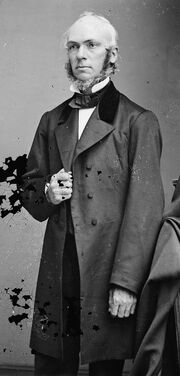
James Strong (1822–1894)
Strong's Exhaustive Concordance of the Bible, generally known as Strong's Concordance, is a concordance of the King James Version (KJV) of the Bible that was constructed under the direction of Dr. James Strong (1822–1894) and first published in 1890. Dr. Strong was Professor of exegetical theology at Drew Theological Seminary at the time. It is an exhaustive cross-reference of every word in the KJV back to the word in the original text.
Unlike other Biblical reference books, the purpose of Strong's Concordance is not to provide content or commentary about the Bible, but to provide an index to the Bible. This allows the reader to find words where they appear in the Bible. This index allows a student of the Bible to re-find a phrase or passage previously studied or to compare how the same topic is discussed in different parts of the Bible.
Strong's Concordance includes:
- The 8674 Hebrew root words used in the Old Testament. Example: Hebrew word #582 in Strong's
- The 5624 Greek root words used in the New Testament. Example: Greek word #3056 in Strong's
James Strong did not construct Strong's Concordance by himself; it was constructed with the effort of more than a hundred colleagues. It has become the most widely used concordance for the King James Version of the Bible.
Each original-language word is given an entry number in the dictionary of those original language words listed in the back of the concordance. These have become known as the "Strong's numbers". The main concordance lists each word that appears in the KJV Bible in alphabetical order with each verse in which it appears listed in order of its appearance in the Bible, with a snippet of the surrounding text (including the word in italics). Appearing to the right of scripture reference is the Strong's number. This allows the user of the concordance to look up the meaning of the original language word in the associated dictionary in the back, thereby showing how the original language word was translated into the English word in the KJV Bible.
New editions of Strong's Exhaustive Concordance of the Bible are still in print (in 2007). Additionally, other authors have used Strong's numbers in concordances of other Bible translations, such as the New International Version and American Standard Version. These are often also referred to as Strong's Concordances.
Although the Greek words in Strong's Concordance are numbered 1–5624, the numbers 2717 and 3203–3302 are unassigned due to "changes in the enumeration while in progress". Not every distinct word is assigned a number, but only the root words. For example, αγαπησεις is assigned the same number as αγαπατε — both are listed as Greek word #25 in Strong's
"αγαπαω".
Strong's Concordance is not a translation of the Bible nor is it intended as a translation tool. The use of Strong's numbers is not a substitute for professional translation of the Bible from Hebrew and Greek into English by those with formal training in ancient languages and the literature of the cultures in which the Bible was written.
Since Strong's Concordance identifies the original words in Hebrew and Greek, Strong's Numbers are sometimes misinterpreted by those without adequate training to change the Bible from its accurate meaning simply by taking the words out of cultural context. The use of Strong's numbers does not consider figures of speech, metaphors, idioms, common phrases, cultural references, references to historical events, or alternate meanings used by those of the time period to express their thoughts in their own language at the time. As such, professionals and amateurs alike must consult a number of contextual tools to reconstruct these cultural backgrounds. Many scholarly Greek and Hebrew Lexicons (e.g., Brown-Driver-Briggs Hebrew Lexicon, Thayer's Greek Dictionary, and Vine's Bible Dictionary) also use Strong's numbers for cross-referencing, encouraging hermeneutical approaches to study.
This concordance is in the public domain (no copyright).
See also[]
External links[]
- Old and New Testaments with every word linked to Strong's Concordance
- Several English versions of OT and NT with Greek and Hebrew words linked to Strong's Concordance
- Strong's Concordance Online Searchable
- Strong's Concordance online
- Look up words in Strong's Concordance
- Look up Greek words in Strong's Greek Dictionary
- Download Strong's Greek Dictionary in XML form
- Look up Greek Septuagint words in AB-Strong's Concordances
- Distributions évangéliques du Québec Concordance des mots français de la Bible ou Concordances des mots hébreux et grecs de la Bible
| This page uses Creative Commons Licensed content from Wikipedia (view authors). |